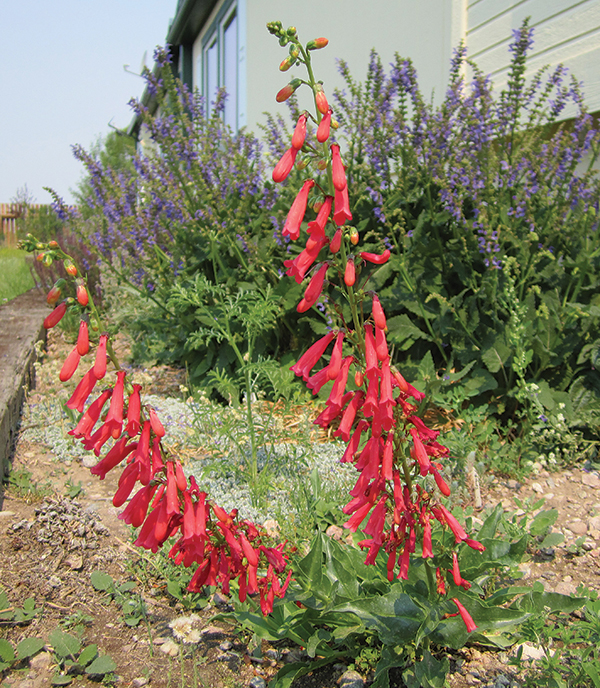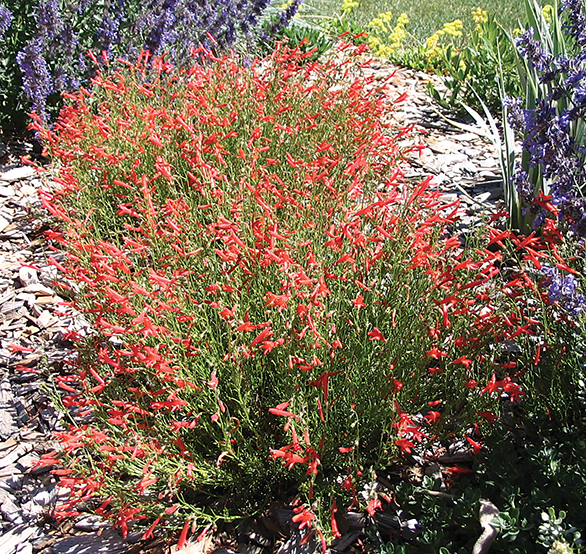-

2
Beardlip Penstemon
Penstemon barbatus (Cav.) Roth



Penstemon is the largest genus of wildflowers restricted to the new world—mostly north of Mexico. In Wyoming, there are more than 40 species, some broadly distributed and some restricted to very narrow ranges. The common name of beardtongue refers to the often-hairy staminode that protrudes slightly from the corolla and looks just like a hairy tongue. The flowers of the beardlip beardtongue are red, a color not found in any Wyoming native penstemon; fortunately, it grows well here. It, and another excellent red species, the firecracker penstemon (P. eatonii A. Gray), flowers later in the season than the blue penstemons—usually July and August. Firecracker penstemon’s bright red flowers can reach to 40” in height; both red species attract hummingbirds and hawk moths. Penstemon barbatus has been used as a parent for a number of hybrids and cultivars, mostly red or pink. Pineleaf beardtongue (P. pinifolius Greene) is another bright-red choice; it is only a foot tall and can sometimes suffer winterburn (i.e., the foliage browns and dies) from excessive winter exposure to sun and drying winds.
For blue-to-purple penstemons, visit Rocky Mountain Beardtongue. For pink penstemons, visit Palmer's Beardtongue.
Height: 18-30”
Width: 10-18”
Water needs: very low
Exposure: full sun
Availability in nurseries: common, as are a number of hybrids and cultivars of P. barbatus
Native range: P. barbatus, southern CO south to Mexico; P. eatonii, similar and into NV and CA; P. pinifolius, NM and AZ
Plant family: Plantaginaceae
Height: 18-30”
Width: 10-18”
Water needs: very low
Exposure: full sun
Availability in nurseries: common, as are a number of hybrids and cultivars of P. barbatus
Native range: P. barbatus, southern CO south to Mexico; P. eatonii, similar and into NV and CA; P. pinifolius, NM and AZ
Plant family: Plantaginaceae

Photo by Jennifer Thompson
Other Red Beardtongues
Firecracker Penstemon

Photo by Jennifer Thompson
Pineleaf Beardtongue

Photo by Jennifer Thompson
For blue-to-purple penstemons, visit Rocky Mountain Beardtongue. For pink penstemons, visit Palmer's Beardtongue.
Navigation
- Beardlip Penstemon
- Black-Eyed Susan
- Blanket Flower
- Blue Flag Iris
- Blue Sage, Pitcher Sage
- Colorado Four O’Clock
- Columbine
- Cutleaf Daisy
- Desert Prince’s Plume
- Dotted Blazing Star
- Easter Daisy, Townsend’s Daisy
- Garrett’s Firechalice
- Harebells
- Kelsey’s Phlox, Marsh phlox
- Lewis’ Flax
- Milkweed
- Missouri Evening Primrose
- Narrow-Leaf Coneflower
- Palmer's Beardtongue
- Pasqueflower
- Perennial Sunflower
- Poppy Mallow, Prairie Wine Cups
- Prairie Smoke
- Purple Prairie Clover
- Rocky Mountain Beardtongue
- Sand Phlox, Cleft Phlox
- Scarlet Gilia
- Scarlet Globemallow, Cowboy's Delight
- Sharp-Leaf Twinpod
- Small-Leaf Pussytoes
- Soapweed Yucca
- Stemless Four-Nerve Daisy
- Sugarbowl Clematis
- Sulfur Buckwheat
- Tufted Evening Primrose
- Upright Prairie Coneflower


